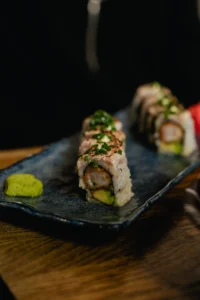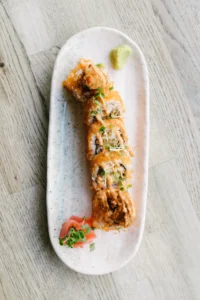Sushi Global Popularity: Why the World Can’t Get Enough
Sushi global popularity continues to rise as this centuries-old Japanese delicacy evolves into a beloved culinary experience worldwide. Today, it’s as likely to appear in a Michelin-starred restaurant as in a grab-and-go lunch box. What was once considered exotic has become part of everyday life for millions. But why has sushi earned such enduring admiration from so many – from fine-dining enthusiasts to health-focused eaters and busy professionals alike?
Sushi Global Popularity and the Celebration of Taste and Texture
At its essence, sushi is a study in balance – delicate vinegared rice paired with fresh seafood, crisp vegetables, and the occasional hint of wasabi heat. Yet, beyond its simplicity lies infinite variety.
Classic purists gravitate toward silky slices of tuna or salmon draped over rice as nigiri. Meanwhile, creative chefs reimagine sushi with playful twists – think tempura prawn rolls with spicy mayo, tropical fruit accents, or vegan versions bursting with avocado, tofu, or pickled radish. This endless adaptability ensures sushi remains both familiar and ever-evolving, delighting adventurous eaters and traditionalists alike.
Health and Harmony on a Plate
 In an era where conscious eating defines much of modern dining, sushi aligns naturally with the global shift towards lighter, nutrient-rich meals. Fresh fish brings essential omega-3 fatty acids, rice provides clean carbohydrates, and seaweed adds vital minerals. Compared to most processed fast foods, sushi offers a wholesome yet flavourful alternative.
In an era where conscious eating defines much of modern dining, sushi aligns naturally with the global shift towards lighter, nutrient-rich meals. Fresh fish brings essential omega-3 fatty acids, rice provides clean carbohydrates, and seaweed adds vital minerals. Compared to most processed fast foods, sushi offers a wholesome yet flavourful alternative.
It’s no wonder athletes, wellness enthusiasts, and busy urbanites alike turn to sushi for its balance of taste and nutrition. Even plant-based diners have an abundance of options – proving sushi’s versatility extends well beyond its traditional roots.
Food as Art: The Beauty of Presentation
Few dishes demonstrate the marriage of culinary skill and artistry as elegantly as sushi. Each roll, slice, and garnish reflects precision, colour harmony, and visual storytelling.
From the brilliant orange of salmon to the emerald hue of avocado and the glistening sheen of tuna, sushi captivates before the first bite. This aesthetic quality has made it a favourite subject on social media platforms, where striking images of sushi platters dominate feeds. Many chefs now design plates with this visual appeal in mind – blending craftsmanship with digital-age marketing.
Sushi Global Popularity and the Global Sushi Boom
Sushi’s widespread appeal is visible in its global reach. From bustling New York avenues to suburban towns in Europe and the Pacific, sushi restaurants thrive in every corner of the world.
The expansion hasn’t been limited to fine dining; instead, it has reached conveyor-belt venues, takeaway kiosks, and supermarket counters. As a result, sushi has become accessible to nearly everyone across different lifestyles and budgets. Moreover, markets in countries such as the Netherlands, Australia, and Canada continue to reflect growing demand and enthusiasm. Ultimately, this global reach stands as a testament to sushi’s ability to transcend borders and cultural preferences.
The Social Side of Sushi
 Dining on sushi often feels like a shared ritual. Whether presented as an elaborate platter among friends or a quick office lunch between colleagues, sushi invites conversation and connection.
Dining on sushi often feels like a shared ritual. Whether presented as an elaborate platter among friends or a quick office lunch between colleagues, sushi invites conversation and connection.
Sharing rolls encourages experimentation – swapping favourites, comparing textures, or discovering new flavour combinations together. The very act of dipping sushi into soy sauce or rolling hand-formed cones adds a tactile, communal element that turns eating into an experience.
Sushi Global Popularity and the Rise of Home-Made Sushi
Beyond restaurants, sushi has found new life in home kitchens. The accessibility of fresh ingredients, online tutorials, and DIY kits has inspired countless people to try their hand at rolling maki or forming nigiri.
This trend has made sushi-making both a creative outlet and a social activity. Families bond over assembling their own rolls; dinner hosts impress guests with colourful platters. In doing so, people forge a more personal connection with the dish – deepening its cultural reach even further.
From Luxury Indulgence to Everyday Favourite
There was a time when sushi was considered a rare indulgence, reserved for special occasions. Today, it has become part of everyday life – found in supermarket aisles, cafés, and even airport lounges.
Its accessibility is one of its greatest strengths. Whether enjoyed as a light lunch, a romantic dinner, or a festive party centrepiece, sushi seamlessly fits into any occasion or lifestyle. This flexibility has solidified its status as a global staple rather than a passing food trend.
Sushi Global Popularity and a Reflection of Japan’s Culinary Legacy
Sushi’s success reflects the broader international fascination with Japanese cuisine. Alongside ramen, tempura, and matcha desserts, sushi has introduced the world to Japan’s emphasis on seasonality, precision, and respect for ingredients.
Yet, its evolution continues. The Californian Roll gave sushi an American identity, while European chefs have experimented with truffle, balsamic glaze, and Mediterranean vegetables. In Latin America, Peruvian and Brazilian influences introduced spicy, citrus-forward notes reminiscent of ceviche. This adaptability keeps sushi relevant, dynamic, and ever-inspiring.
The Lasting Appeal
More than just a meal, sushi represents the harmony of flavour, form, and culture. It satisfies the senses, supports health-conscious habits, and brings people together – whether around a restaurant table or a kitchen counter.
From its humble beginnings in Japan to its modern-day global presence, sushi has transcended boundaries and expectations. It is not merely a culinary export but a universal language of craftsmanship and connection – one that continues to evolve, enchant, and endure.
